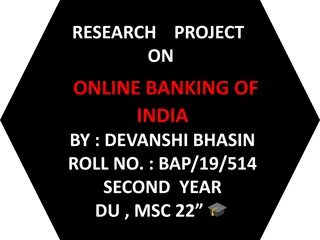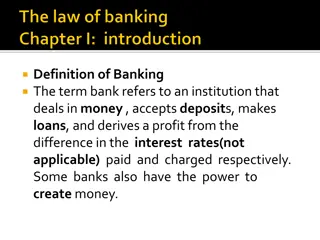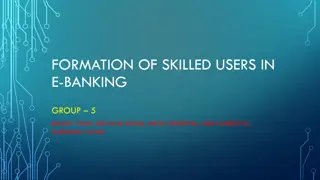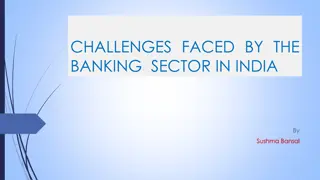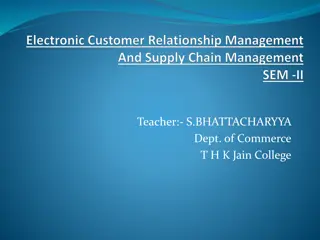Benefits of E-Banking and Its Impact on Customer Service
E-banking provides various benefits such as offering extra service channels, convenience, flexibility with online banking, reduction in cash transactions, self-inquiry facilities, remote and anytime banking, branch networking, and electronic data interchange. These benefits enhance customer service by providing 24/7 access to banking services, preventing cash-related risks, and enabling easy transactions without physical visits to the bank. The use of technology in electronic banking improves overall customer experience and efficiency in managing financial transactions.
Uploaded on Sep 10, 2024 | 0 Views
Download Presentation

Please find below an Image/Link to download the presentation.
The content on the website is provided AS IS for your information and personal use only. It may not be sold, licensed, or shared on other websites without obtaining consent from the author.If you encounter any issues during the download, it is possible that the publisher has removed the file from their server.
You are allowed to download the files provided on this website for personal or commercial use, subject to the condition that they are used lawfully. All files are the property of their respective owners.
The content on the website is provided AS IS for your information and personal use only. It may not be sold, licensed, or shared on other websites without obtaining consent from the author.
E N D
Presentation Transcript
E-banking is very important because of the benefits management derive from it. Some of these major benefits are briefly described below.
Choice Offering extra service delivery channels means wider choice and convenience for customers, which itself is an improvement in customer service. and Convenience for Customers:
Offer flexibility with online banking Delivering banking products and services to the door-step of customers Reduction in the use of cash for transactions Provision of 24/7 banking services Prevention of customers from carrying cash which can be an attraction for robbery This is achieved through the following means:
Self-inquiry facility: Facility for logging into specified self-inquiry terminals at the branch to inquire and view the transactions on the account. Remote banking: Remote terminals at the customer site connected to the respective branch through a customer to make inquiries regarding his accounts, on-line, without having to move from his office. modem, enabling the
Anytime banking- Anywhere banking: Installation of ATMs which offer non-stop cash withdrawal, remittances and inquiry facilities. Branch Networking: computerized branches inter-city and intra-city, will permit customers of these branches, when interconnected, to transact from any of these branches. Also through Tele-banking, A 24-hour service through which inquiries regarding balances and transactions in the account can be made over the phone.
Electronic Banking has also enables the bank to provide corporate or high value customers with a Graphical User Interface (GUI) software on a PC, to inquire about their financial transactions and accounts, cash transfers, cheque book issue and inquiry on rates without visiting the bank. Moreover, LC text and details on bills can be sent by the customer, and the bank can download the same. The technology used to provide this service is called electronic data interchange (EDI). It is used to transmit business transactions
Attracting High Value Customers E-banking often attracts high profit customers with higher than average income and education levels, which helps to increase the size of revenue streams. For a retail bank, e-banking customers are therefore of particular interest, and such customers are likely to have a higher demand for banking products.
Most of them are using online channels regularly for a variety of purposes, and for some there is no need for regular personal contacts with the bank s branch network, which is an expensive channel for banks to run (Berger & Gensler, 2007).
E-banking helps to enhance the image of the organization as a customer focused innovative organization. especially true in early days when only the most innovative implementing this channel. This was organizations were
Despite its common availability today, an attractive banking website with a large portfolio of innovative enhances a bank s image. This image also helps in becoming effective at e-marketing and attracting customer base products still young/professional
Increased revenues as a result of offering e- channels are often reported, because of possible increases in the number of customers, retention of existing customers opportunities. and cross selling Whether reasonable return on investment (ROI) from these channels is an ongoing debate. these revenues are enough for
It has also allowed banks to diversify their value creation activities. E-banking has changed the traditional retail banking business model in many ways, for example by making it possible for banks to allow the production and delivery of financial services to be separated into different businesses.
This means that banks can sell and manage services offered by other banks (often foreign banks) to increase their revenues. This is an especially possibility for smaller banks with a limited product range attractive
Traditionally, when a bank wanted to expand geographically it had to open new branches, thereby incurring high maintenance costs. E-channels, such as the Internet, have made this unnecessary in many circumstances. Now banks with a traditional customer base in one part of the country or world can attract customers from other parts, as most of the financial transaction do not require a physical presence near customers living/working place. start up and
E-marketing in the financial services sector was made possible by the arrival of e-banking. E-marketing builds on the e-channel s ability to provide detailed data financial profiles and purchasing behaviour. Detailed understanding of customers enables customised advertising, customised products and enrichment of customers through such activities as cross selling. about customers the relationship with
E-Channels are largely automatic, and most of the routine activity such as account checking or bill payment may be carried out using these channels. This usually results in load reduction on other delivery channels, such as branches or call centres.
The main economic argument of e-banking so far has been reduction of overhead costs of other channels such as branches, which require expensive buildings and a staff presence. It also seems that the cost per transaction of e- banking often falls more rapidly than that of traditional banks once a critical mass of customers is achieved.
To implement e-banking, organizations often have to re-engineer their business processes, integrate systems and promote agile working practices. These steps, which are often pushed to the top of the agenda by the desire to achieve e-banking, often result in greater efficiency and agility in organizations.
Immediate replies to customer queries without reference to ledger-keeper as terminals are provided to Managers and Chief Managers. Automatic and prompt carrying out of standing instructions on due date and generation of reports. Generation of various periodical returns on due dates. Fast and up-to-date information transfer enabling speedier decisions, by interconnecting computerized branches and controlling offices. MIS reports and
Accurate computing of cumbersome and time- consuming jobs such as balancing and interest calculations on due dates. Automatic printing of covering schedules, deposit receipts, pass book / pass sheet, freeing the staff from performing these time-consuming jobs, and enabling them to give more attention to the needs of the customer. Signature retrieval facility, assisting in verification of transactions, sitting at their own terminal. Avoidance of duplication of entries due to existence of single-point data entry.
Other potential benefits of e-banking to organizations may include: improved use of IT resources and business processes; better relationships customers; quick delivery of products and services; and a reduction in data entry and customer services related errors. with suppliers/









